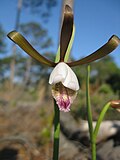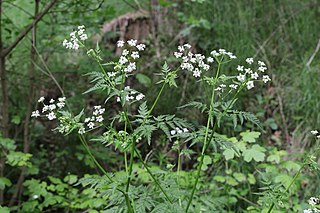
Anthriscus sylvestris, known as cow parsley, wild chervil, wild beaked parsley, Queen Anne's lace or keck, is a herbaceous biennial or short-lived perennial plant in the family Apiaceae (Umbelliferae),. It is also sometimes called mother-die, a name that is also applied to the common hawthorn. It is native to Europe, western Asia and northwestern Africa. It is related to other diverse members of Apiaceae, such as parsley, carrot, hemlock and hogweed. It is often confused with Daucus carota, another member of the Apiaceae also known as "Queen Anne's lace" or "wild carrot".

Caladenia, commonly known as spider orchids, is a genus of 350 species of plants in the orchid family, Orchidaceae. Spider orchids are terrestrial herbs with a single hairy leaf and a hairy stem. The labellum is fringed or toothed in most species and there are small projections called calli on the labellum. The flowers have adaptations to attract particular species of insects for pollination. The genus is divided into three groups on the basis of flower shape, broadly, spider orchids, zebra orchids and cowslip orchids, although other common names are often used. Although they occur in other countries, most are Australian and 136 species occur in Western Australia, making it the most species-rich orchid genus in that state.

Maianthemum canadense is an understory perennial flowering plant, native to Canada and the northeastern United States, from Yukon and British Columbia east to Newfoundland, into St. Pierre and Miquelon. It can be found growing in both coniferous and deciduous forests. The plant appears in two forms, either as a single leaf rising from the ground with no fruiting structures or as a flowering/fruiting stem with two to three leaves. Flowering shoots have clusters of 12–25 starry-shaped, white flowers held above the leaves.

Spiranthes spiralis, commonly known as autumn lady's-tresses, is an orchid that grows in Europe and adjacent North Africa and Asia. It is a small grey-green plant. It forms a rosette of four to five pointed, sessile, ovate leaves about 3 cm (1.2 in) in length. In late summer an unbranched stem of about 10–15 cm (3.9–5.9 in) tall is produced with approximately four sheath-shaped leaves. The white flowers are about 5 mm (0.20 in) long and have a green spot on the lower lip. They are arranged in a helix around the upper half of the stalk. The species is listed in Appendix II of CITES as a species that is not currently threatened with extinction but that may become so. Autumn lady's-tresses are legally protected in Belgium and the Netherlands, and in some regions of France.

Neotinea ustulata, the burnt orchid or burnt-tip orchid, is a European terrestrial orchid native to mountains in central and southern Europe, growing at up to 2,400 m (7,900 ft) elevation. The plant is considered Endangered in Great Britain and Least Concern internationally based on IUCN Red List criteria. The burnt-tip orchid was voted the county flower of Wiltshire in 2002 following a poll by the wild flora conservation charity Plantlife.

Neottia ovata, the common twayblade or eggleaf twayblade, is a terrestrial orchid widespread across much of Europe and Asia
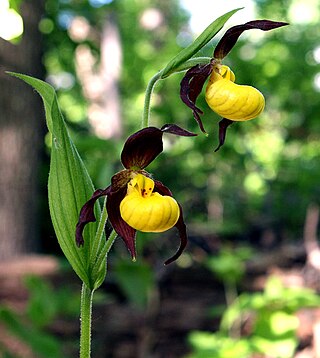
Cypripedium parviflorum, commonly known as yellow lady's slipper or moccasin flower, is a lady's slipper orchid native to North America. It is widespread, ranging from Alaska south to Arizona and Georgia. It grows in fens, wetlands, shorelines, and damp woodlands.
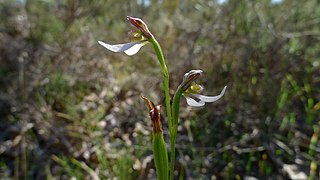
Eriochilus, commonly known as bunny orchids, is a genus of flowering plants in the orchid family, Orchidaceae that is endemic to Australia. Orchids in this genus are distinguished from those in the similar Caladenia by having a glabrous leaf and a densely woolly labellum. Species occur in south-west Western Australia, South Australia, Queensland, New South Wales, the Australian Capital Territory, Victoria, and Tasmania. Their common name alludes to their prominent ear-like lateral sepals.

Thelymitra pauciflora, commonly called the slender sun orchid in Australia and maikaika or maika in New Zealand is a species of orchid in the family Orchidaceae. It is one of the most widespread and common orchid species in Australia, growing in all states except Western Australia and the Northern Territory, and also in New Zealand including Chatham Island.

Traunsteinera, the round headed orchid, or globe orchid, is a genus of flowering plants from the orchid family, Orchidaceae.

Roscoea cautleyoides is a perennial herbaceous plant occurring in the Sichuan and Yunnan provinces of China. The scientific name is also spelt Roscoea cautleoides. Most members of the ginger family (Zingiberaceae), to which it belongs, are tropical, but R. cautleyoides, like other species of Roscoea, grows in much colder mountainous regions. It is sometimes grown as an ornamental plant in gardens.

Roscoea humeana is a species of flowering plant in the family Zingiberaceae. It is a perennial occurring in the Sichuan and Yunnan provinces of China. Most members of the ginger family, to which it belongs, are tropical, but R. humeana, like other species of Roscoea, grows in much colder mountainous regions. It is also grown as an ornamental plant in gardens.

Roscoea tibetica is a perennial herbaceous plant native to the mountains of China, being found in Tibet, Sichuan and Yunnan. The species formerly included plants found in Bhutan; in 2000, these were separated into a new species, Roscoea bhutanica. Most members of the ginger family (Zingiberaceae), to which it belongs, are tropical, but R. tibetica, like other species of Roscoea, grows in much colder mountainous regions. R. tibetica is sometimes grown as an ornamental plant in gardens. In 2020, it was proposed that R. tibetica be split again.
Roscoea cangshanensis is a perennial herbaceous plant native to the mountains of China, being found in Yunnan. Most members of the ginger family (Zingiberaceae), to which it belongs, are tropical, but R. canshanensis, like other species of Roscoea, grows in much colder mountainous regions.

Roscoea nepalensis is a perennial herbaceous plant found in Nepal. Most members of the ginger family (Zingiberaceae), to which it belongs, are tropical, but R. nepalensis, like other species of Roscoea, grows in much colder mountainous regions.

Eriophorum scheuchzeri is a species of flowering plant in the sedge family known by the common names Scheuchzer's cottongrass and white cottongrass. It has an arctic circumpolar and circumboreal distribution in the Northern Hemisphere. It can be found in Alaska, across Canada, in the Arctic islands, Greenland, Iceland, and across Eurasia. Disjunct occurrences exist in the Rocky Mountains, in the high mountains of southern Europe and on Mount Daisetsu in Japan and some other Asian mountains.

Cleistesiopsis bifaria, the smaller spreading pogonia, is a terrestrial species of orchid native to the eastern United States, along the Appalachian Mountains from West Virginia to Alabama. Flower petals are white or rose-pink in color with purple or pink venation. Its habitats include savannas, wet meadows, and pine or oak woodlands of ridgetops. The species is threatened by fire suppression, habitat loss, and invasive species.

Praecoxanthus aphyllus, commonly known as leafless orchid, is the only species of the flowering plant genus Praecoxanthus in the orchid family, Orchidaceae and is endemic to the south-west of Western Australia. Plants in flower lack a true leaf, although those plants that are not flowering do possess a green leaf. This species is one of the first orchids to flower each year and its creamy white, fragrant flower easily distinguishes it from other species.

Thelymitra alpina, commonly known as the mountain sun orchid, is a species of orchid that is endemic to south-eastern Australia. It has a single dark green leaf with a purplish base and up to twenty, usually blue to purplish flowers. It grows in alpine, subalpine and montane areas of New South Wales, the Australian Capital Territory and Victoria.
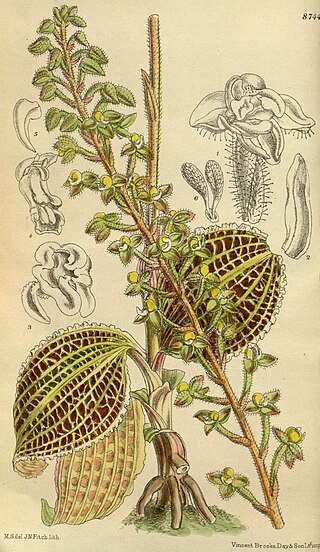
Macodes sanderiana(Kraenzl.) Rolfe is a species of South East Asian jewel orchid mostly recorded from New Guinea but is also found in the Solomon Islands and Vanuatu. This species has a long history of cultivation in Europe since the early 20th century and is prized for its ornamental leaves which are the largest in its genus. The leaves are dark green, the upper surface covered in an intricate network of veins in colors ranging from bright green to copper. In contrast, flowers are small and pallid so are often removed in cultivation. In nature, M. sanderiana grows in rainforests on the forest floor or lithophytically out of rock crevices. This species survives at a broad range of altitudes from close to sea-level, up to the lower boundary of the cloud forest. Exudates from the leaves of this orchid are traditionally used in New Guinea as eye drops for the treatment of myopia. M. sanderiana has not been assessed for the IUCN red list, however, as recently as the 1980’s this species was common in parts of its range within New Guinea.



